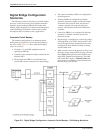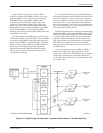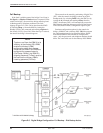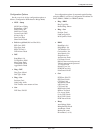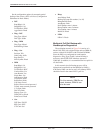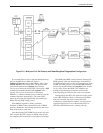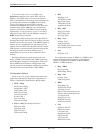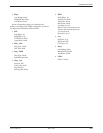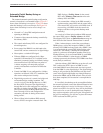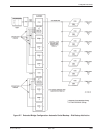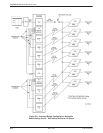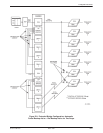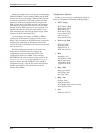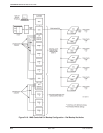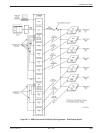
COMSPHERE 3600 Series Data Service Units
D-14 March 1999 3610-A2-GB41-60
Automatic Partial Backup Using an
Extended Bridge
The assumed automatic partial backup configuration
scenario, where there is an extended bridge, (Figure D-7
shows when dial backup is not active, Figure D-8 shows
when dial backup is active on all drops, and Figure D-9
shows when dial backup is active on two drops) is as
follows:
• Network is a 7-drop DDS multipoint network
operating at 9600 bps.
• Customer wishes automatic backup controlled by
the tributary DSUs.
• The control and tributary DSUs are configured for
mixed diagnostics.
• Seven central-site DBM-Vs are dedicated to the
control DSU and are connected to its digital bridge.
• Host requires a switched LSD signal.
• Tributary DBMs are configured for 9.6 kbps
operation, LSD emulation (V.13 switched carrier
emulation), automatic backup, no fallback, backup
on network fault or LSD Off, time-out period of
1 minute, outgoing call setup with password
security, and automatic restoration of DDS after
5 minutes.
• Central-site DBM-Vs are configured for 9.6 kbps
operation, no fallback, LSD (V.13) emulation, and
auto-answer with password security.
• Digital bridge consists of a central-site bridge and
an extended bridge working in tandem. The
central-site bridge has Bridge Rate set to =DSU,
has Ports DCE (first port of the digital bridge)
through Prt6 active and configured for contention,
and takes its timing from the DDS system clock.
The extended bridge has Bridge Rate set to 9.6, has
Ports 2 through 4 active and configured for
contention, and takes its timing from external
timing on Prt1.
• When a failure in the backbone DDS network
occurs, all DSUs recognize a network fault. The
NMS displays a Facility Alarm for the control
DSU and a Tributary Time-out alarm for each
tributary DSU and DBM.
• It is assumed that a failure in the DDS network is
not between the control DSU and the central office.
(The control DSU still receives valid DDS clock. If
not receiving valid DDS clock, the central-site
bridge would have to be put into Backup mode
manually).
As a result of a failure in the backbone DDS network,
the control DSU reports a Facility Alarm to the NMS.
The tributary DSUs show an Out-of-Service message on
their DCPs and the Network Timeout timer is started.
When 1 minute elapses, each of the seven tributary
DBMs places a call to their respective DBM-Vs. (Each
tributary DSU-DBM has been paired with a DBM-V that
is associated with the control DSU-digital bridge at the
central site. The tributary’s Backup Dir configuration
option is a pointer to the telephone number stored in its
Backup Directory for its associated DBM-V; each DBM
calls a different DBM-V.) After the pairs of DBMs
exchange passwords, the tributary DSU-DBMs enter Data
mode (ready to send data).
After the tributary DSU-DBM has set up the call, each
DSU switches the DTE’s data to its DBM. As each
associated DBM-V enters Data mode, the data is passed
from the DBM-V to the digital bridge. The digital bridge’s
timing is still provided by the DDS network, and elastic
stores in the digital bridge buffer any timing differences
between the DBMs and the DDS network. After all calls
have been completed, full restoration is accomplished at
9600 bps.
It is not likely that backup can be accomplished before
the network has timed out and the affected tributaries have
been taken off the host’s active list. However, if they are
placed on an FEP’s slow poll list, they will be placed back
on the active list as soon as backup has been completed;
they can then respond to polls once again. If dropped from
the poll list completely, you will have to place the remote
DTEs back onto the FEP’s poll list.



